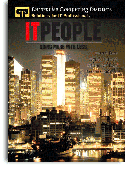IT Systems Management – Table of Content
Designing, Implementing, and Managing World-Class Infrastructures
First edition; 528 pages
ISBN 0-13-087678-X
( by: Rich Schiesser )
Table of Content
Part 1- Background
Chapter 1: Historical Perspective
- Introduction
- Systems Management: A Proposed Definition
- Time Lining Early Developments of Systems Management
- The Need for a General-Purpose Computer
- A Brief Look at IBM
- Summary
Chapter 2 : Evolving in the 1970’s and 1980’s
- Introduction
- General Purpose Becomes General Expansion
- Evolving S/360 into S/370
- Significant IT Developments during the 1980’s
- Continuing Evolution of Mainframe Computers
- Extended Use of Midrange Computers
- Proliferation of Personal Computers
- Emergence of Client-Server Systems
- Impact of 1980s’ IT Developments on New Systems
- Management Functions
- Impact of 1980s’ IT Developments on Existing Systems
- Management Functions
- Summary
Chapter 3 : Into and Beyond the New Millennium
- Introduction
- Reinventing the Mainframe
- The Changing of Midrange and Client-Server Platforms
- The Growing Use of PC’s and Networks
- The Global Growth of the Internet
- Lingering Effects of the Millennium Bug
- Time Lining the Disciplines of Systems Management
- Summary
Part 2 – People
Chapter 4 : Acquiring Executive Support
- Introduction
- Why Executive Support is Especially Critical Today
- Building a Business Case for Systems Management
- Educating Executives on the Value of Systems Management
- Three Universal Principles Involving Executive Support
- Ensuring Ongoing Executive Support
- Summary
Chapter 5 : Organizing for Systems Management
- Introduction
- Factors to Consider in Designing IT Organizations
- Factors to Consider in Designing IT Infrastructures
- Locating Departments in the Infrastructure
- Recommended Attributes of Process Owner
- Summary
Chapter 6 : Staffing for Systems Management
- Introduction
- Determining Required Skill Sets and Skill Levels
- Assessing the Skill Levels of Current Onboard Staff
- Alternative Sources of Staffing
- Recruiting Infrastructure Staff from the Outside
- Selecting the Most Qualified Candidate
- Retaining Key Personnel
- Using Consultants and Contractors
- Benefits of Using Consultants and Contractors
- Drawbacks of Using Consultants and Contractors
- Summary
Chapter 7 : Customer Service
- Introduction
- How IT Evolved into a Service Organization
- The Four Key Elements of Good Customer Service
- Identifying Your Key Customers
- Identifying Key Services of Key Customers
- Identifying Key Processes that Support Key Services
- Identifying Key Suppliers that Support Key Processes
- Integrating the Four Key Elements of Good Customer Service
- The Four Cardinal Sins that Undermine Good Customer Service
- Summary
Part 3 Processes
Chapter 8 : Availability
- Introduction
- Definition of Availability
- Differentiating Availability from Uptime
- Differentiating Slow Response from Downtime
- Differentiating Availability from High Availability
- Desired Traits of an Availability Process Owner
- Methods for Measuring Availability
- The Seven R’s of High Availability
- Assessing an Infrastructure’s Availability Process
- Measuring and Streamlining the Availability Process
- Summary
Chapter 9 : Performance and Tuning
- Introduction
- Differences between the performance and Tuning Process and Other Infrastructure Processes
- Definition of Performance and Tuning
- Preferred Characteristics of a Performance and Tuning Process Owner
- Performance and Tuning Applied to the Five Major Resources Environments
- Server Environment
- Disk Storage Environment
- Database Environment
- Network Environment
- Desktop Computer Environment
- Assessing an Infrastructure’s Performance and Tuning Process
- Measuring and Streamlining the Performance and Tuning Process
- Summary
Chapter 10 : Production Acceptance
- Introduction
- Definition of Production Acceptance
- The Benefits of a Production Acceptance Process
- Implementing a Production Acceptance Process
- Full Deployment of a New Application
- Distinguishing New Applications from New Versions of Existing Applications
- Distinguishing Production Acceptance from Change Management
- Assessing an Infrastructure’s Production Acceptance Process
- Measuring and Streamlining the Production Acceptance Process
- Summary
Chapter 11 : Change Management
- Introduction
- Definition of Change Management
- Drawbacks of Most Change Management Processes
- Key Steps Required in Developing a Change Management Process
- Emergency Changes Metric
- Assessing an Infrastructure’s Change Management Process
- Measuring and Streamlining the Change Management Process
- Summary
Chapter 12 : Problem Management
- Introduction
- Definition of Problem Management
- Scope of Problem Management
- Distinguishing among Problem, Change, and Request Management
- Key Steps to Developing a Problem Management Process
- Opening and Closing Problems
- Segregating and Integrating Help Desks
- Client Issues with Problem Management
- Assessing an Infrastructure’s Problem Management Process
- Measuring and Streamlining the Problem Management Process
- Summary
Chapter 13 : Storage Management
- Introduction
- Definition of Storage Management
- Desired Traits of a Storage Management Process Owner
- Storage Management Capacity
- Storage Management Performance
- Storage Management Reliability
- Storage Management Recoverability
- Assessing an Infrastructure’s Storage Management Process
- Measuring and Streamlining the Storage Management Process
- Summary
Chapter 14 : Network Management
- Introduction
- Definition of Network Management
- Key Decisions about Network Management
- Assessing an Infrastructure’s Network Management Process
- Measuring and Streamlining the Network Management Process
- Summary
Chapter 15 : Configuration Management
- Introduction
- Definition of Configuration Management
- Practical Tips for Improving Configuration Management
- Assessing an Infrastructure’s Configuration Management Process
- Measuring and Streamlining the Configuration Management Process
- Summary
Chapter 16 : Capacity Planning
- Introduction
- Definition of Capacity Planning
- Why Capacity Planning is Seldom Done Well
- How to Develop an Effective Capacity Planning Process
- Additional Benefits of Capacity Planning
- Helpful Hints for Effective Capacity Planning
- Uncovering the Hidden Costs of Upgrades
- Assessing an Infrastructure’s Capacity Planning Process
- Measuring and Streamlining the Capacity Planning Process
- Summary
Chapter 17 – Strategic Security
- Introduction
- Definition of Strategic Security
- Developing a Strategic Security Process
- Assessing an Infrastructure’s Strategic Security Process
- Measuring and Streamlining the Security Process
- Summary
Chapter 18 : Disaster Recovery
- Introduction
- Definition of Disaster Recovery
- Case Study: Disaster at the Movie Studio
- Three Important Lessons Learned
- Steps to Developing an Effective Disaster Recovery Process
- Nightmare Incidents with Disaster Recovery Plans
- Assessing an Infrastructure’s Disaster Recovery Process
- Measuring and streamlining the Disaster Recovery Process
- Summary
Chapter 19 : Facilities Management
- Introduction
- Definition of Facilities Management
- Major Elements of Facilities Management
- The Facilities Management Process Owner
- Determining the Scope of Responsibilities of a Facilities Management Process Owner
- Desired Traits of a Facilities Management Process Owner
- Evaluating the Physical Environment
- Major Physical Exposures Common to a Data Center
- A Word About Efficiency and Effectiveness
- Tips to Improve the Facilities Management Process
- Assessing an Infrastructure’s Facilities Management Process
- Measuring and Streamlining the Facilities Management Process
- Summary
Part 4 – Technology
Chapter 20 : Developing Robust Process
- Introduction
- What Contributes to a World-Class Infrastructure
- Characteristics of a Robust Process
- Understanding the Differences Between a Formal and Informal Process
- Helpful Ground Rules for Brainstorming
- Methods for Prioritizing Requirements
- Summary
Chapter 21 : Using Technology to Automate and Evaluate Robust Process
- Introduction
- Automating Robust Processes
- Evaluating an Infrastructure Process
- Evaluating Process Documentation
- Benefits of the Methodology to Evaluate Process
- Documentation
- Summary
Chapter 22 :Integrating Systems Management Processes
- Introduction
- Distinguishing Strategic Processes from Tactical Process
- Identifying Strategic Processes
- Identifying Tactical Processes
- The Values of Distinguishing Strategic from Tactical Processes
- Relationships Between Strategic and Tactical Processes
- Difficulties with Integrating Solely Tactical Processes
- Difficulties with Integrating Solely Strategic Processes
- Difficulties with Integrating Solely Tactical and Strategic Processes
- Examining the Integrated Relationships Between Strategic and Tactical Processes
- Significance of Systems Management Process Relationships
- Summary
Chapter 23 : Special Considerations for Client-Server and Web-Enabled Environments
- Introduction
- Client-server Environment Issues
- Vendor Relationships
- Multiplatform Support
- Performance Tuning Challenges
- Disaster Recovery Planning
- Capacity Planning
- Web- Enabled Environment Issues
- Traditional Companies
- Moderate and Growing Companies
- Dotcom Companies
- Summary
Part 5 – Appendices
- Appendix A
- Frequently Asked Questions
- Appendix B
- Summary of Definitions
- Appendix C
- Assessment Worksheets Without Weighting Factors
- Appendix D
- Assessment Worksheets With Weighting Factors
- Bibliography
- Index
- About the Author

















